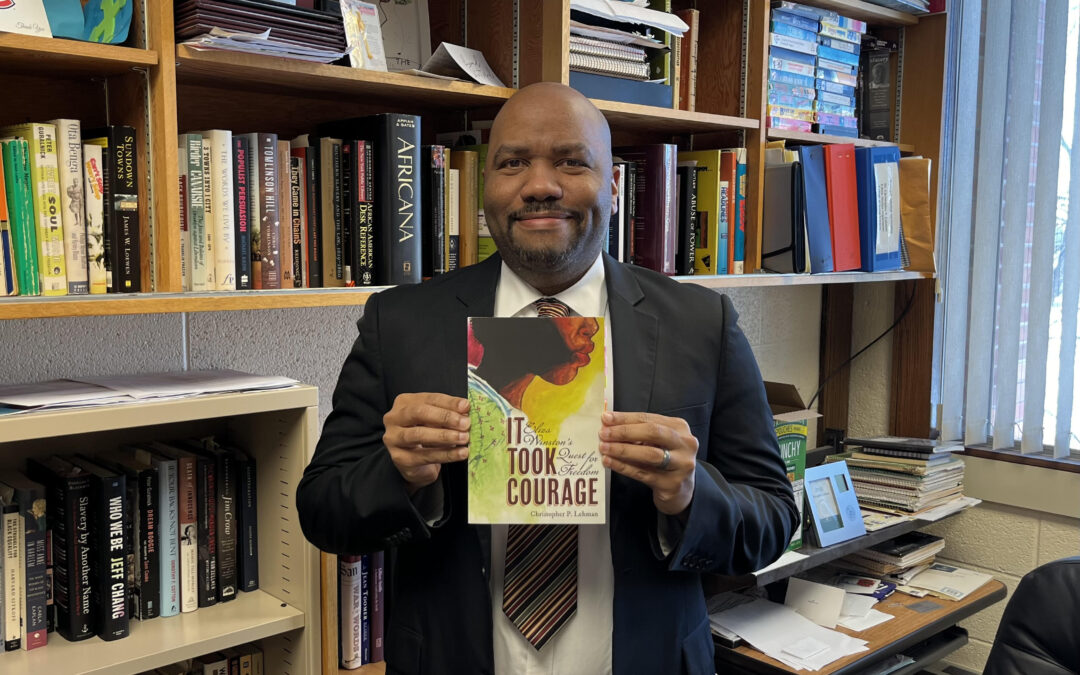Article by Eli Holm. Photo by Eli Holm.
When Minnesota declared statehood in 1858, its constitution forbade the practice of slavery, enshrining it as a free state in the Antebellum period, but that doesn’t mean that slavery did not affect Minnesota.
Dr. Christopher Lehman, Author, Historian, and Professor of Ethnic Studies at St. Cloud State, is at the forefront of demonstrating these effects. His education, research, and bibliography aim to reshape Minnesota’s relationship with slavery.
Through investigation into Minnesota’s public records, court documents, and paper trails, Dr. Lehman’s work reveals that as a territory, Minnesota’s infrastructure was paid for by investment from southern slaveholders. Lehman has found that despite slave labor not being used to build Minnesota’s original towns, the wealth made from slave labor was the capital investment that started the construction.
These findings became the subject of Lehman’s sixth book, “Slavery’s Reach: Southern Slaveholders in the North Star State”.
“My hope in telling a story about Minnesota during the years of legal slavery in the United States is for readers to understand that [despite] Minnesota being so far up to the north, and for having very few African Americans, and very few enslavers, it didn’t really matter when it came to slaveholders being determined to make their mark on Minnesota,” Lehman said. “The slaveholders didn’t even have to bring slaves with them to do that, they just brought their pocketbooks.”
Lehman’s approach to Minnesotan history through the perspective of slavery in “Slavery’s Reach” led to his first recognition from the Minnesota Book Awards in 2020, in which he won the Book of the Year award in the Minnesota Nonfiction category.
However, it was the critical response to “Slavery’s Reach” that compelled Lehman when planning for his next book.
“Some people expressed sadness or disappointment that I didn’t give [the book] a protagonist or someone to root for,” Lehman said. “I wrote about a few people who had been enslaved in Minnesota but who were freed, so whichever person has the largest paper trail, then that will be who I write about next.”
The person who had the most identifiable paper trail was Eliza Winston, a slave from Mississippi who was taken to Minnesota on her enslavers vacation. Despite the ban on slavery, the practice of Southern wealth vacationing with slaves under the title of “servant” was largely ignored. While in Minnesota, Winston met with abolitionist movements and fought for liberation, and her determination for emancipation led to her standing before a Minneapolis court and winning her freedom after nearly four decades of enslavement.
Her story would become the subject of Lehman’s most recent book and second nomination for the Minnesota Book Award Minnesota Nonfiction Category: “It Took Courage: Eliza Winston’s Quest for Freedom”.
The book continues to examine the connections made in “Slavery’s Reach,” but the paper trails Lehman explored led to him applying a new historical perspective, one that sought to rethink how Winston’s story was told.
In the early pages of the book, Lehman writes that due to Winston leaving the state three months after her emancipation, the allies and abolitionists in Minnesota recounting her story tended to skew their involvement as the focus.
“[From] the sources that I had already seen, they tended to minimize Eliza’s role in her own pursuit of freedom,” Lehman said. “I wanted to have the book place Eliza front and center in her own story.”
Lehman’s extensive research through public records revealed that Winston’s liberation campaign was something instigated by her. He writes about her role in abolitionist activism, as well as her relentless pursuit of justice in the court of law.
“[Eliza Winston] was just relentless in her determination to be freed, and her cleverness, finding different resources, and making different alliances, in order to make that happen,” Lehman said. “Regardless of where she was, whenever she was trying to become free, she tried to do it within the law.”
Additionally, Lehman’s research into Winston’s story led to him unearthing a surprising national connection.
“It turns out that John McLemore [a former enslaver of Eliza Winston] and President Andrew Jackson were best friends, and they both married into the same family, the Donelsons,” Lehman said. “Andrew’s love for his in-laws was what motivated him to step in when money trouble forced McLemore to sell all his enslaved people. He paid for another Donelson to buy Eliza Winston and keep her until McLemore’s daughter Kate was all grown up, who could then inherit her father’s enslaved person.”
Since the publication of “It Took Courage” in the spring of last year, Lehman has been reflecting on what lessons people can take from Winston’s story, as well as what Minnesota’s economic ties to slavery say about the present moment.
“[It Took Courage] has served as a cautionary tale for what happens when any community is taken over by moneyed interests, by people who are rich and who have sway over people who are elected officials,” Lehman said.
The “moneyed interests” Lehman refers to are the politicians and lobbyists who, in 1860, the year of Winston’s emancipation, put money into amending the constitution as a slave state, intending to win back southern slaveholders’ investment.
“To go to the extent where you are willing to change a free state into a slave state on the basis of money and courting wealth from slave labor,” Lehman said. “That says something about how attractive money is, how attractive power is, and how using that attraction to affect government can be to the detriment of many people.”
Learn more about Dr. Lehman and “It Took Courage” via, the Minnesota Historical Society’s website.






Recent Comments